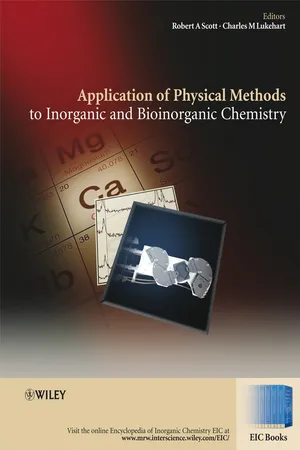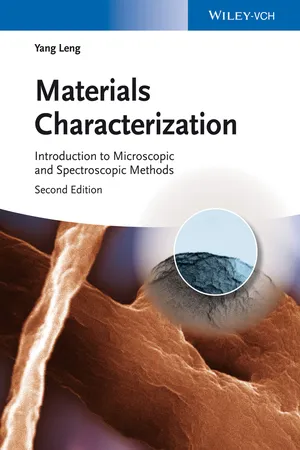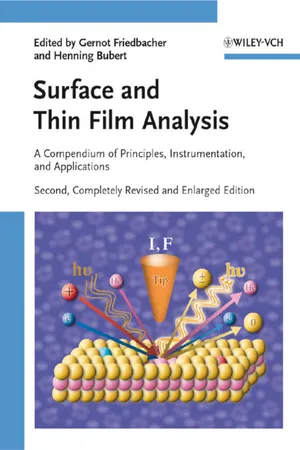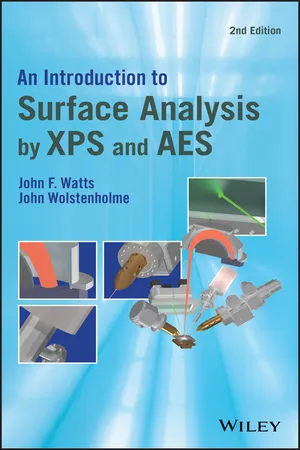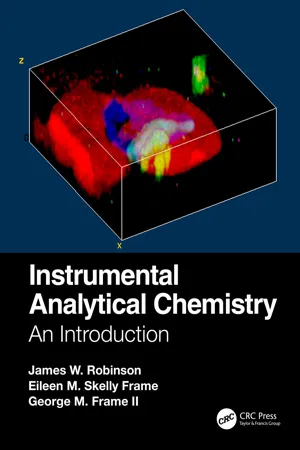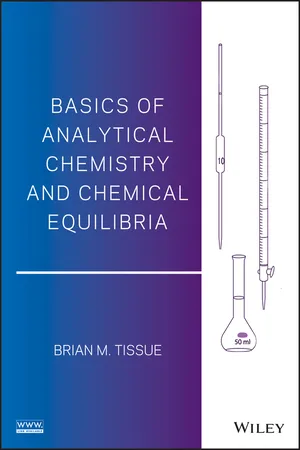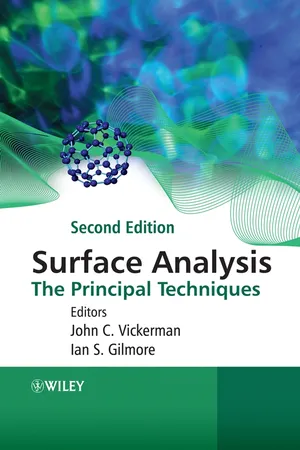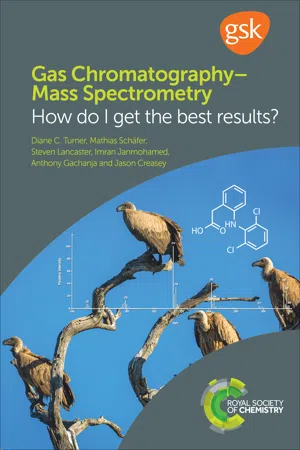Chemistry
Ion and Atom Photoelectron Spectroscopy
Ion and atom photoelectron spectroscopy is a technique used to study the energy levels and electronic structure of atoms and ions. By measuring the kinetic energy of photoelectrons emitted from the sample, valuable information about the ionization energy and electronic configuration can be obtained. This method is widely used in chemistry to understand the behavior of atoms and ions in various chemical processes.
Written by Perlego with AI-assistance
Related key terms
Related key terms
1 of 4
Related key terms
1 of 3
10 Key excerpts on "Ion and Atom Photoelectron Spectroscopy"
- Robert A. Scott, Charles M. Lukehart, Robert A. Scott, Charles M. Lukehart(Authors)
- 2013(Publication Date)
- Wiley-Interscience(Publisher)
IE ).(1)Ionization is explicitly defined in terms of transitions between the ground state of a molecule and ion states as shown in equation (2 ).(2 )The information obtained from photoelectron spectroscopy is typically discussed in terms of the electronic structure and bonding in the ground states of molecules, with ionization of electrons occurring from bonding molecular orbitals, lone pairs, antibonding molecular orbitals, or atomic cores. These descriptions reflect the relationship of ionization energies to the molecular orbital model of electronic structure. The ionization energies are directly related to the energies of molecular orbitals by Koopmans’ Theorem,2 which states that the negative of the eigenvalue of an occupied orbital from the Hartree–Fock model of the electronic structure is equal to the vertical ionization energy to the ion state formed by removal of an electron from that orbital, provided the distributions of the remaining electrons do not change. While there are limitations to the applicability of Koopmans’ theorem3 in a first order approximation, each ionization of a molecule can be described as removal of an electron from an individual orbital. The ionization energies can then be considered as measures of orbital stabilities, and shifts can be interpreted in terms of orbital stabilizations or destabilizations due to changes in electron distributions and bonding.Photoelectron spectroscopy remains among the most direct and comprehensive experimental probes of electronic structure. Photoelectron spectroscopy of neutral molecules in the gas phase has served as a particularly important basis for the bonding models used to describe inorganic molecules because the energetics of ion formation from the neutral ground state are directly related to the orbital electron configurations, oxidation states, charge distributions, and covalency. Photoelectron spectroscopy has become an established field over the last 40 years, with several books available on the subject.4 –6There are also review articles on gas-phase photoelectron spectroscopy of neutral transition metal molecules,3 ,7 –9- eBook - ePub
Materials Characterization
Introduction to Microscopic and Spectroscopic Methods
- Yang Leng(Author)
- 2013(Publication Date)
- Wiley-VCH(Publisher)
Chapter 7
Electron Spectroscopy for Surface Analysis
Electron spectroscopy is a technique that uses characteristic electrons emitted from a solid for elemental analysis, not for microstructure imaging as in electron microscopy. The characteristic electrons (either Auger electrons or photoelectrons) exhibit characteristic energy levels, revealing the nature of chemical elements in the specimens being examined. Auger or photoelectrons can only escape from the uppermost atomic layers of solid (a depth of 10 nm or less) because their energies are relative low (generally 20–2000 eV), while the characteristic X-rays can escape from a much greater depth (several micrometers from the surface). Thus, electron spectroscopy is a technique for surface chemical analysis. There are two types of electron spectroscopy: Auger electron spectroscopy (AES ) and X-ray photoelectron spectroscopy (XPS ). Auger electrons and photoelectrons are different in their physical origins, but both types of electrons carry similar information about chemical elements in material surfaces.7.1 Basic Principles
7.1.1 X-Ray Photoelectron Spectroscopy
The X-ray photoelectron is an electron ejected from an electron shell of an atom when the atom absorbs an X-ray photon. Figure 7.1 a schematically illustrates the emission of a photoelectron from an atom when it is excited by an X-ray photon. As mentioned in Chapter 6, an incident X-ray photon can have sufficient energy (a value of hv) to knock out an inner-shell electron, for example, from the atom's K shell. In such a case, the K-shell electron would be ejected from the surface as a photoelectron with kinetic energy EK . Knowing the kinetic energy EK , we can calculate the binding energy of the atom's photoelectron (EB ) based on the following relationship7.1Φ is the parameter representing the energy required for an electron to escape from a material's surface, h is Planck's constant and ν is the frequency. The value of Φ depends on both the sample material and the spectrometer. The binding energies of atomic electrons have characteristic values, and these values are used to identify elements, similar to the way that the characteristic X-ray energy is used in X-ray spectroscopy. XPS identifies chemical elements from the binding energy spectra of X-ray photoelectrons. A typical XPS spectrum is a plot of intensity versus binding energy. Photoelectrons are ejected from different electronic shells and subshells. Each binding energy peak is marked as an element symbol plus a shell symbol from where the photoelectron was emitted, for example, Al 2p, O 1s, and so on, as shown in Figure 7.2 . The photoelectrons emitted by subshells p, d, and f are commonly marked with an additional fraction number; for example, . There are and for the p subshell, and for the d subshell, and and for the f subshell. These fractions represent the quantum number of total angular momentum (J) for an individual shell electron, as mentioned in Section 6.1.1. An XPS spectrum may also contain peaks from Auger electrons. For example, the spectrum shown in Figure 7.2 includes Auger electron peaks marked as O KLL and C KLL - eBook - ePub
Surface and Thin Film Analysis
A Compendium of Principles, Instrumentation, and Applications
- Gernot Friedbacher, Henning Bubert, Gernot Friedbacher, Henning Bubert(Authors)
- 2011(Publication Date)
- Wiley-VCH(Publisher)
Part One: Electron Detection 2 X-Ray Photoelectron Spectroscopy (XPS) Henning Bubert, John C. Rivière, and Wolfgang S.M. WernerX-ray photoelectron spectroscopy (XPS) is one of the most widely used surface analytical techniques, and is therefore described here in more detail than any of the other techniques. At its inception by Siegbahn and coworkers [1], it was called ESCA (electron spectroscopy for chemical analysis), but the name ESCA is now considered too general, as many surface electron spectroscopies exist, and the name given to each one must be precise. Nevertheless, the name ESCA is still used in many places, particularly in industrial laboratories and their publications. Briefly, the reasons for the popularity of XPS are the exceptional combination of compositional and chemical information that it provides, its ease of operation, and the ready availability of commercial equipment.2.1 PrinciplesThe surface to be analyzed is irradiated with soft X-ray photons. When a photon of energy hν interacts with an electron in a level with binding energy E B (E B is the energy E K of the K-shell in Figure 2.1 ), the entire photon energy is transferred to the electron, with the result that a photoelectron is ejected with kinetic energy(2.1)where ΦS is a small, almost constant, work-function term.Figure 2.1 Schematic diagram of electron emission processes in solids. Left: Auger process; Right: photoelectron emission process. Electrons involved in the emission processes are indicated by open circles.Obviously, hν must be greater than E B . The ejected electron may come from a core level or from the occupied portion of the valence band, but in XPS most attention is focused on the electrons in core levels. As no two elements share the same set of electronic binding energies, measurement of the photoelectron kinetic energies enables elemental analysis . In addition, Equation 2.1 indicates that any changes in E B are reflected in E kin , which means that changes in the chemical environment of an atom can be followed by monitoring changes in the photoelectron energies, leading to the provision of chemical information - John F. Watts, John Wolstenholme(Authors)
- 2019(Publication Date)
- Wiley(Publisher)
5. For convenience, the subscripts are sometimes omitted.1.3 X‐ray Photoelectron Spectroscopy
In XPS we are concerned with a special form of photoemission, i.e. the ejection of an electron from a core level caused by an X‐ray photon of energy hv. The energy of the emitted photoelectron is then analysed by the electron spectrometer and the data presented as a graph of intensity (usually expressed as counts or counts per second) versus electron energy; the X‐ray induced photoelectron spectrum.The kinetic energy (EK ) of the electron is the experimental quantity measured by the spectrometer, but this is dependent on the energy of the X‐ray source employed and is therefore not an intrinsic material property. The binding energy of the electron (EB ) is the parameter which identifies the electron specifically, both in terms of its parent element and atomic energy level. The relationship between the parameters involved in the XPS experiment is as follows:Where hv is the photon energy, EK is the kinetic energy of the electron, and ϕ is the work function of the spectrometer.As all three quantities on the right‐hand side of the equation are known or measurable, it is a simple matter to calculate the binding energy of the electron. In practice, this task will be performed by the control electronics or data system associated with the spectrometer and the operator merely selects a binding or kinetic energy scale whichever is considered the more appropriate. It should be emphasised that the positions of XPS peaks on the binding energy scale are independent of the X‐ray photon energy but the positions of X‐ray induced Auger peaks will depend upon the photon energy. On the other hand, if the spectrum is displayed on a kinetic energy scale then the position of the Auger peaks will remain constant while the position of the XPS peaks will change with photon energy.- eBook - ePub
Instrumental Analytical Chemistry
An Introduction
- James W. Robinson, Eileen M. Skelly Frame, George M. Frame II(Authors)
- 2021(Publication Date)
- CRC Press(Publisher)
However, matter composed of molecules, atoms, or ions, which exists as solid or liquid or gas, exhibits primarily the properties of particles. Spectroscopy studies the interaction of light with matter defined as materials composed of molecules or atoms or ions. In a gas, atoms or molecules are widely separated from each other; in liquids and solids, the atoms or molecules are closely associated. In solids, the atoms or molecules may be arranged in a highly ordered array, called a crystal, as they are in many minerals, or they may be randomly arranged, or amorphous, as they are in many plastics. Atoms, molecules, and ions are in constant motion whatever their physical state or arrangement. For molecules, many types of motion are involved. Molecules can rotate, vibrate, and translate (move from place to place in space). Interaction with radiant energy can affect these molecular motions. Molecules that absorb IR radiation vibrate with greater amplitude; interaction with UV or visible light can move bonding electrons to higher energy levels in molecules. A change in any form of motion or electron energy level involves a change in the energy of the molecule. Such a change in energy is called a transition ; we have the possibility of vibrational, rotational, and electronic transitions in molecules. We have some of the same kinds of motion in atoms and ions. Atoms can move in space, and their electrons can move between energy levels, but atoms and monoatomic ions cannot rotate or vibrate. The chemical nature of matter (its composition), its physical state, and the arrangement of the atoms or molecules in the physical state with respect to each other affect the way in which any given material interacts with electromagnetic radiation. Table 2.2 lists some of the important types of transitions studied by spectroscopy. We will cover these techniques in detail in later chapters. There are many types of transitions and types of spectroscopy used to investigate matter - No longer available |Learn more
- Brian M. Tissue(Author)
- 2013(Publication Date)
- Wiley(Publisher)
Chapter 9: Atomic Spectrometry
Learning Outcomes- Describe the major instrument components of atomic absorption spectrometry (AAS), atomic emission spectrometry (AES), and inductively coupled plasma mass spectrometry (ICP-MS).
- Identify the characteristics that distinguish different atomic spectrometry methods.
- Use spectrometric data to calculate unknown concentrations.
Elemental analysis is exactly what the name implies, determining the elemental composition of a sample. This term refers to several different classes of methods depending on the concentration range being measured. Elemental analysis at the percentage level is accomplished using the classical methods discussed in Chapter 3. Analyses to determine the empirical formula of a molecule are performed in dedicated instruments called elemental, combustion, or CHN analyzers. CHN refers to carbon (C), hydrogen (H), and nitrogen (N) and variations include CHNO, CHNO/S, etc. In these instruments, a pure sample is combusted completely and the elemental composition is determined by measuring the relative amounts of the combustion products (see Examples 3.1–3.4). There are also a number of instrumental methods for direct elemental analysis of solids. These include X-ray fluorescence (XRF) and X-photoelectron spectroscopy (XPS). These methods are beyond the scope of this text, but their underlying principles are similar to any spectroscopic method.This chapter describes the most common methods of elemental analysis at trace-level concentrations, less than approximately 100 ppm. Advanced instruments have the widest dynamic range, with some being capable of measurements up to 1%. Detection limits depend on the element, but for many metals the LOD can be less than 1 ppb. Most of these measurements are used for samples that are or that can be placed in aqueous solution. For the most part, these are laboratory-based instruments, although some specialized portable instruments are available.1 - eBook - ePub
- Terrance E. Conners, Sujit Banerjee(Authors)
- 2020(Publication Date)
- CRC Press(Publisher)
Because of solid state effects due to bonding to other atoms, the energy and the distribution of these electronic states are modified and depend strongly on the nature of the chemical bond and the crystallographic environment. The difference between the chemical effects as observed in photoelectron spectroscopy (XPS) and EELS (which is similar to x-ray absorption spectroscopy, XAS) is that the former technique is only sensitive to core level shifts whereas, for the latter technique, the effect is a combination of core and final state shifts and the sensitivity to the density distribution of the unoccupied states. Although providing more information, the interpretation of EELS spectra is more difficult. To this simplified picture other effects contribute to the modification of the fine structure as multi-electron and excitonic effects alter the detailed structure. Although the detailed modelling of these effects is starting to show some success, 36-38 the “fingerprinting” approach is often used to identify or distinguish: i) the nature of the environment (e.g., the O K edges in FeO, α-Fe 2 O 3, γ-Fe 2 O 3, Fe 3 O 4 are different 39); ii) the coordination and symmetry of the atomic site (Si L edge in the SiO 4 unit in different minerals); and Hi) the bonding character (e.g., Al K in the metal and in an oxide are different). These effects have been recently reviewed by Brydson et al. 40 Interesting examples in organic chemistry are variations in the fine structure on the C K edge of the nucleic acids 41 and various other polymeric molecules. 42 APPLICATIONS TO PAPER FIBERS Previous applications of EELS to problems in the pulp and paper industry have not been documented in the literature. However, as different portions of the EELS spectrum can be used to characterize a material and to provide information about the chemical composition and electronic structure, the technique should be useful for fundamental investigations or for the study of contaminants - Franklin Tao(Author)
- 2023(Publication Date)
- Wiley(Publisher)
3 Fundamentals of X‐ray Photoelectron Spectroscopy3.1 Principle of XPS
X‐ray photoelectron spectroscopy (XPS) is one of the main analytical techniques in catalysis, surface science, materials science, and energy science. Majority of these elements constituting heterogeneous catalysts are transition metals. About half of these transition metals used in heterogeneous catalysts have quite low abundances in the earth as shown in Figures 3.1 and 3.2 . Efficient use of these transition metal elements, particularly these low abundance metal elements in catalysis significantly relies on qualitative identification and quantitative analyses of these elements on a catalyst surface using XPS. XPS analyzes binding energy (BE) of photoelectrons of subshell of atoms upon irradiation of a sample with X‐ray of a specific energy (hν) through an accurate measurement of kinetic energy of the electrons emitted from these subshells. Sometimes the electrons in subshell are called core electrons as they are electrons in a core shell in contrast to electrons in valence shell. In other words, an electron of an atom is either a core electron or a valence shell electron. Binding energy is calculated through the equation, BE = hν – KE – φ; here BE, KE, and φ are binding energy of a photoelectron, kinetic energy of the photoelectron and work function of the XPS spectrometer, respectively. It can analyze most elements of the periodic table.Figure 3.3a lists binding energies of the most intense or/and most used sub‐shells. Once an element is suspected, its most intense or most used subshell and the corresponding binding energy can be found from the reference periodic table in Figure 3.3a . With this reference table (Figure 3.3a ), the constituting elements of the catalyst surface can be identified. The XPS peak intensity of a subshell such as Pt 4f is proportional to the number of Pt atoms and the photoionization cross section of Pt 4f at a specific radiation such as Al Kα. The photo‐ionization cross sections of most elements excited with a radiation at an energy of 1486.6 eV (Al Kα), 1253.6 eV (Mg Kα), 1041.0, 800.0, 600.0, 300.0, or 200.0 eV1,2 are listed in Figure 3.3b , c , d , e , f , g , h , and i , respectively. For instance, by dividing XPS peak intensity of a subshell such as Pt 4f with the photo‐ionization cross section corresponding to the radiation used to excite the subshell electrons available in one of the reference tables in Figure 3.3b ‐i , the number of Pt atoms in surface region can be evaluated. With the same method, the number of atoms of another constituting element such as Ce can be evaluated. Due to the difference in inelastic mean free paths of the two subshells of the two elements, the atomic ratio of the two elements in the same region such as the top 1 nm region can be found out upon calibration with their inelastic mean free paths. A significant application of these photoionization cross sections of different radiations to most elements represented in Figure 3.3b –i is to accurately, readily measure the atomic ratio of two elements in the surface region of a catalyst if synchrotron radiations with variable energies can be accessed. For instance, both Pt and Ce elements coexist in a catalyst. For example, to measure the atomic ratio of Pt/Ce, we can choose 1041 and 200 eV radiations to excite Ce 3d and Pt 4f, respectively to generate Ce 3d and Pt 4f photoelectrons with energies in the range of 120–160 eV. The photoionization cross sections of Ce 3d excited with radiation of 1041 eV and Pt 4f with radiation of 200 eV can be readily found from Figure 3.3e and i- eBook - ePub
Surface Analysis
The Principal Techniques
- John C. Vickerman, Ian S. Gilmore, John C. Vickerman, Ian S. Gilmore(Authors)
- 2011(Publication Date)
- Wiley(Publisher)
Photoabsorption, Photoionization, and Photoelectron Spectroscopy . New York, NY: Academic Press; 1979.20. Feldman LC and Mayer JW. Fundamentals of Surface and Thin Film Analysis . New York, NY: North Holland; 1986.21. Hoffman R. Solids and Surfaces. A Chemists View of Bonding in Extended Structures ,Volume1. New York, NY: VCH Publishers; 1988.22. Koopmans TS. Über die Zuordnung von Wellenfunktionen und Eigenwerten zu den Einzelnen Elektronen eines Atoms. Physica 1934; 1: 104–113.23. Beamson G and Briggs D. High Resolution XPS of Organic Polymers . Chichester, UK: John Wiley & Sons, Ltd; 1992.24. Brundle CR, Chuang TJ and Rice DW. X-Ray Photoemission Study of Interaction of Oxygen and Air with Clean Cobalt Surfaces. Surface Science 1976; 60: 286–300.25. McIntyre NS and Cook MG. X-Ray Photoelectron Studies on Some Oxides and Hydroxides of Cobalt, Nickel, and Copper. Analytical Chemistry 1975; 47: 2208–2213.26. Shirley DA. Many-electron and Final-state Effects: Beyond the One-electron Picture. In: CardonaMandLeyL(Editors). Photoemission in Solids . Berlin: Springer-Verlag; 1978. pp. 165–195.27. Anthony MT and Seah MP. XPS – Energy Calibration of Electron Spectrometers.1. An Absolute, Traceable Energy Calibration and the Provision of Atomic Reference Line Energies. Surface and Interface Analysis 1984; 6: 95–106.28. Briggs D and Seah MP. Practical Surface Analysis . Chichester, UK: John Wiley & Sons, Ltd; 1990.29. Seah MP. Post-1989 Calibration Energies for X-Ray Photoelectron Spectrometers and the 1990 Josephson Constant. Surface and Interface Analysis 1989; 14: 488.30. Seah MP, Gilmore IS and Spencer SJ. Measurement of data for and the development of an ISO standard for the energy calibration of X-ray photoelectron spectrometers. Applied Surface Science 1999; 145: 178–182.31. Seah MP, Gilmore IS and Spencer SJ. XPS: Binding energy calibration of electron spectrometers 4 – Assessment of effects for different x-ray sources, analyser resolutions, angles of emission and overall uncertainties. Surface and Interface Analysis 1998; 26 - eBook - ePub
Gas ChromatographyMass Spectrometry
How Do I Get the Best Results?
- Diane C Turner, Mathias Schäfer, Steven Lancaster, Imran Janmohamed, Anthony Gachanja, Jason Creasey(Authors)
- 2019(Publication Date)
- Royal Society of Chemistry(Publisher)
7 Basic Aspects of Mass Spectra InterpretationThis chapter will address the following questions: How do I use mass spectrometry for qualitative analysis? How to identify unknown compounds? How do I determine the quantity of a compound with a GC-MS?
7.1 What Information Does the Molecular Ion in EI-MS [M]+ ˙ Give Me?
7.1.1 What Is a Molecular Ion?
We have seen that the molecules can be ionized using different methods. The nature of the molecular ion is dependent on the way it was formed. In electron (impact) ionization (EI)-MS the molecular ion [M]+ ˙ is generated by loss of an electron (Section 5.4.1, Chapter 5). The respective molecular ion must have an odd number of electrons and is a radical cation = OE+ ˙ (OE+ ˙ odd electron number ion). In chemical ionisation (CI) however, the choice of the reagent gas determines whether the molecular ion is an OE+ ˙ type ion, generated via charge exchange, or is produced via protonation (see Section 5.4.2, Chapter 5). In the latter process molecular ions are closed shell species of the type [M + H]+ and have an even electron number (EE+ ions). It is therefore important to note that a correct interpretation of a mass spectrum starts with the correct understanding of the ionisation method used. The nature of the molecular ion is especially important for the correct determination of molecular compositions on the basis of accurate ion mass measurements and is also crucial for the correct understanding of fragmentation patterns.In the following discussion we want to concentrate on the interpretation of EI-MS spectra as those are by far the most important ones in GC-MS. As discussed in Section 5.4.1 in Chapter 5 molecular ions [M]+ ˙ generated by EI-MS can either be stable or unstable and the relative intensity of the molecular ions relies strongly on the nature of the analyte. Aside from that, the elemental composition is reflected in the isotopic signal pattern of the molecular ions [M]+
Index pages curate the most relevant extracts from our library of academic textbooks. They’ve been created using an in-house natural language model (NLM), each adding context and meaning to key research topics.
Explore more topic indexes
Explore more topic indexes
1 of 6
Explore more topic indexes
1 of 4
